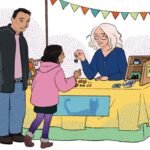
Anselm Kiefer, the celebrated German-born artist, has been named as the latest winner of one of the world’s most prestigious prizes for printmaking, the Queen Sonja Print Award Lifetime Achievement Award. Its previous recipients are David Hockney (2018), Paula Rego (2020) and William Kentridge (2022). The award was announced today by Julia Peyton-Jones, adviser to the Queen Sonja Print Award (QSPA) Board, at a ceremony at the Norwegian embassy, in London.
The award is in recognition of the use that Kiefer—who is known for his monumental textured canvases incorporating industrial found objects and organic materials—has made of woodcuts in the past half-century. Kiefer will receive his award from Queen Sonja of Norway, who is herself a noted printmaker, at a ceremony to be held on 5 and 6 June, in Bodø, north Norway. Bodø is this year’s European City of Culture.
Since the early 1970s, Kiefer has employed woodcuts in some of his artist’s books and collaged these images together to create works on the same scale as his grandest paintings. In one work, Ways of World Wisdom: The Battle of the Teutoburg Forest (1976–80 and 1993), Kiefer worked over the woodcuts with acrylic paint and shellac. Another piece from the same series, Ways of World Wisdom: Hermann’s Battle (1978), is a 10-ft collage formed from woodcut portraits of 17 great German creatives in philosophy, music and literature. In that work, Kiefer asks how Germany—a nation that produced works by figures of such stature—could have fallen under the sway of an anti-intellectual, regressive regime in the Nazi era.
Kiefer was born in 1945, the final year of the Second World War, in Donaueschingen, a town in the Black Forest where the sources of the river Danube converge. He has engaged both with the traditional German form of woodcut, with roots in the earliest printed books, and the work of Old Master artists, reinterpreting them on a large scale. He has used the medium to focus on German history and myth: in the Ways of World Wisdom series, for example, and in his studies from the 1970s and 1980s of Grane. Grane was the great horse on which, in the closing scenes of Wagner’s music drama Götterdämmerung (Twilight of the Gods), the Nibelung princess Brünnhilde rides into the flames of Siegfried’s funeral pyre. Often in his collages, the seams between each individual woodcut are clearly visible.
Kiefer’s works on Wagnerian themes, in which woodcut prints on paper are pasted onto canvas—including Grane (1980), Brünnhilde/Grane (1982/93) and Untitled (The Rhine) (1993)—are often nearly nine square feet in size. A number of his Wagner woodcuts in the collection of the Metropolitan Museum of Art, New York City, made a symbolic journey across town to the Metropolitan Opera for the 2009 loan exhibition From the Met to the Met: Anselm Kiefer and Wagner’s Ring.
In 2016, the Albertina museum in Vienna mounted Anselm Kiefer. The Woodcuts, including works from the woodcut series Ways of Worldly Wisdom: The Battle of Hermann; The Rhine and Brünhilde – Grane. His Untitled (1996), nearly 11 feet tall, is one of a series in which Kiefer depicts towering, decaying sunflowers above an image of a semi-naked man.
The Lifetime Achievement Award is one of three categories of the Queen Sonja Print Award (QSPA). The winners of the others, the Queen Sonja Print Award 2024 and the QSPA Inspirational Award, will be announced in May. The Queen Sonja Art Foundation was founded in 2011 to generate interest in and promote the development of graphic art. The QSPA awards highlight the Norwegian tradition of printmaking, which reached a high point in the early 20th century through the work of the Norwegian modernist Edvard Munch.










